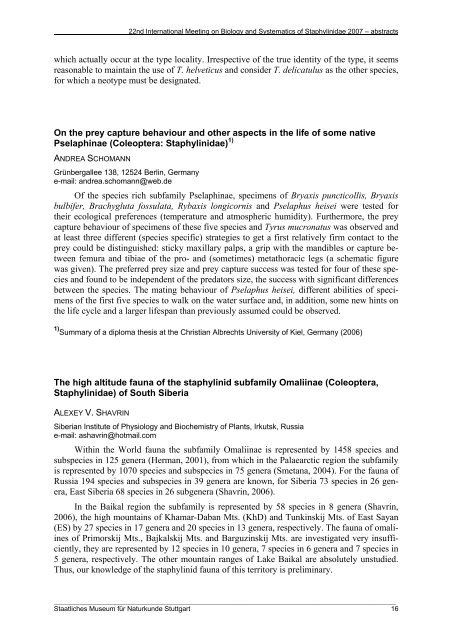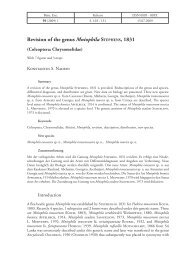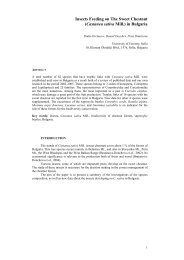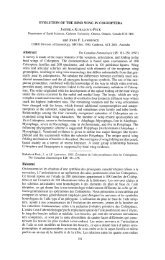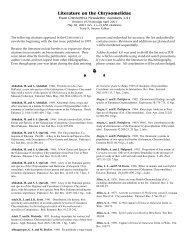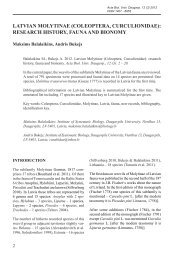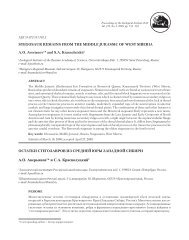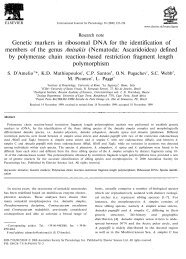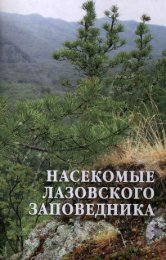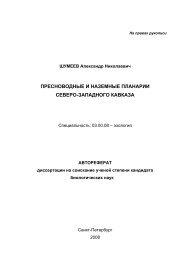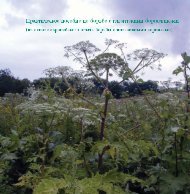International Meeting on Biology and Systematics of Staphylinidae
International Meeting on Biology and Systematics of Staphylinidae
International Meeting on Biology and Systematics of Staphylinidae
Create successful ePaper yourself
Turn your PDF publications into a flip-book with our unique Google optimized e-Paper software.
22nd <str<strong>on</strong>g>Internati<strong>on</strong>al</str<strong>on</strong>g> <str<strong>on</strong>g>Meeting</str<strong>on</strong>g> <strong>on</strong> <strong>Biology</strong> <strong>and</strong> <strong>Systematics</strong> <strong>of</strong> <strong>Staphylinidae</strong> 2007 – abstracts<br />
which actually occur at the type locality. Irrespective <strong>of</strong> the true identity <strong>of</strong> the type, it seems<br />
reas<strong>on</strong>able to maintain the use <strong>of</strong> T. helveticus <strong>and</strong> c<strong>on</strong>sider T. delicatulus as the other species,<br />
for which a neotype must be designated.<br />
On the prey capture behaviour <strong>and</strong> other aspects in the life <strong>of</strong> some native<br />
Pselaphinae (Coleoptera: <strong>Staphylinidae</strong>) 1)<br />
ANDREA SCHOMANN<br />
Grünbergallee 138, 12524 Berlin, Germany<br />
e-mail: <strong>and</strong>rea.schomann@web.de<br />
Of the species rich subfamily Pselaphinae, specimens <strong>of</strong> Bryaxis puncticollis, Bryaxis<br />
bulbifer, Brachygluta fossulata, Rybaxis l<strong>on</strong>gicornis <strong>and</strong> Pselaphus heisei were tested for<br />
their ecological preferences (temperature <strong>and</strong> atmospheric humidity). Furthermore, the prey<br />
capture behaviour <strong>of</strong> specimens <strong>of</strong> these five species <strong>and</strong> Tyrus mucr<strong>on</strong>atus was observed <strong>and</strong><br />
at least three different (species specific) strategies to get a first relatively firm c<strong>on</strong>tact to the<br />
prey could be distinguished: sticky maxillary palps, a grip with the m<strong>and</strong>ibles or capture between<br />
femura <strong>and</strong> tibiae <strong>of</strong> the pro- <strong>and</strong> (sometimes) metathoracic legs (a schematic figure<br />
was given). The preferred prey size <strong>and</strong> prey capture success was tested for four <strong>of</strong> these species<br />
<strong>and</strong> found to be independent <strong>of</strong> the predators size, the success with significant differences<br />
between the species. The mating behaviour <strong>of</strong> Pselaphus heisei, different abilities <strong>of</strong> specimens<br />
<strong>of</strong> the first five species to walk <strong>on</strong> the water surface <strong>and</strong>, in additi<strong>on</strong>, some new hints <strong>on</strong><br />
the life cycle <strong>and</strong> a larger lifespan than previously assumed could be observed.<br />
1) Summary <strong>of</strong> a diploma thesis at the Christian Albrechts University <strong>of</strong> Kiel, Germany (2006)<br />
The high altitude fauna <strong>of</strong> the staphylinid subfamily Omaliinae (Coleoptera,<br />
<strong>Staphylinidae</strong>) <strong>of</strong> South Siberia<br />
ALEXEY V. SHAVRIN<br />
Siberian Institute <strong>of</strong> Physiology <strong>and</strong> Biochemistry <strong>of</strong> Plants, Irkutsk, Russia<br />
e-mail: ashavrin@hotmail.com<br />
Within the World fauna the subfamily Omaliinae is represented by 1458 species <strong>and</strong><br />
subspecies in 125 genera (Herman, 2001), from which in the Palaearctic regi<strong>on</strong> the subfamily<br />
is represented by 1070 species <strong>and</strong> subspecies in 75 genera (Smetana, 2004). For the fauna <strong>of</strong><br />
Russia 194 species <strong>and</strong> subspecies in 39 genera are known, for Siberia 73 species in 26 genera,<br />
East Siberia 68 species in 26 subgenera (Shavrin, 2006).<br />
In the Baikal regi<strong>on</strong> the subfamily is represented by 58 species in 8 genera (Shavrin,<br />
2006), the high mountains <strong>of</strong> Khamar-Daban Mts. (KhD) <strong>and</strong> Tunkinskij Mts. <strong>of</strong> East Sayan<br />
(ES) by 27 species in 17 genera <strong>and</strong> 20 species in 13 genera, respectively. The fauna <strong>of</strong> omaliines<br />
<strong>of</strong> Primorskij Mts., Bajkalskij Mts. <strong>and</strong> Barguzinskij Mts. are investigated very insufficiently,<br />
they are represented by 12 species in 10 genera, 7 species in 6 genera <strong>and</strong> 7 species in<br />
5 genera, respectively. The other mountain ranges <strong>of</strong> Lake Baikal are absolutely unstudied.<br />
Thus, our knowledge <strong>of</strong> the staphylinid fauna <strong>of</strong> this territory is preliminary.<br />
__________________________________________________________________________________________<br />
Staatliches Museum für Naturkunde Stuttgart 16


